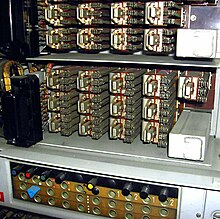Precious metal engine coordinate selector
The precious metal motor coordinate selector ( EMF selector ) is an electromechanical coupling element in analog telephone switching technology .
Development history
In the dialer technology for telephone communication in Germany, two new systems were introduced in the 1950s as the successor to the rotary dial from Siemens:
- EMD = precious metal motor rotary selector
- EMK = precious metal motor coordinate selector
Two automatic telephone exchanges of the EMK system were set up for testing in Berlin in 1952. However, the Deutsche Bundespost had opted for the EMD system. The EMD system was the last electromechanical switching system in Germany. The EMK system was then no longer developed.
Technical brief description
The most remarkable thing about the construction of the precious metal motor coordinate selector (EMF selector) is the structure of the contact bank with prepared contacts and the type of solution to the kinematic task of converting the pure rotary movement of the drive motor into a straight line and a subsequent circular movement of the setting element.
The contact bank of the EMK selector, similar to that of the lever-operated rotary selector, is made up of layered contact rings separated by insulating and metal interlayers. The bank contacts themselves have, however, due to the use of a prepared contact, a completely different shape than the voter constructions with contact brushes that slide or sit on top.
The contact rings used to accommodate the speech wires consist of 11 contact springs arranged on an arc of around 1,200 with double contacts and a continuous contact segment adjacent to them as a mating contact. The two parts making contact are made of precious metal or have a precious metal coating.
On the contact segments are z. B. the incoming lines and the outgoing lines on the contact springs, so that the connection of the incoming with the outgoing line can be established by pressing the relevant contact spring against the contact segment opposite it. The contact bank can be viewed as a large collection of switch contacts. The contact is not made by dragging, as is the case with the rotary lever or motor selector.
The pressing is carried out with the help of the switching arms of the setting element, which pass through the contact rings and thereby actuate the contact springs one after the other. For reasons of transmission technology, the layering of the contact rings is arranged in such a way that the a / b contact rings that belong together lie directly next to one another, namely - the a and b contact springs are each symmetrical to their mating contact segments. The a / b contact spring pairs formed in this way form the paths of the switching arm pair, the switching arms of which slide with inclined surfaces onto the outsides of the a / b contact spring pairs and press them with their contacts against the associated contact segments.
With a view to a favorable dimensioning of the contact bank, the a / b layers (shifting steps, decades) are divided into two groups, one of which contains the layers with all odd a / b contact rings and the other those with the even ones. Each of the two sub-banks is covered by its own pair of switching arms, but only one switching arm carrier is always effective, while the other pair of switching arms runs freely through its sub-bank.
The test leads (c) and, if necessary, the control leads (d) are grouped together in special sub-banks. The associated switching arm also serves here, only as an actuating element and, when passing through the contact bank, presses the contact springs of the individual bank contacts one after the other against the continuous contact segment. All contact rings of the EMK selector are arranged next to one another in vertical planes. The contact springs and the mating contact plates are routed to soldering lugs on the back of the contact bank. Multiple wiring can be designed more cheaply than with lever-operated dials due to the vertical arrangement of the contact levels.
EMF system
| year | 1952 |
| Expandability | unlimited |
| commitment | Full or partial exchange |
| Subscriber connection | Call finder |
| Components |
|
| control | directly |
| Speech ways | Precious metal engine coordinate selector |
| construction | closed rows of frames |
| commitment | DBP Deutsche Bundespost |
Web links
- Description EMK system
- Image collection EMK system
- Precious metal engine coordinate selector (accessed June 30, 2017)

